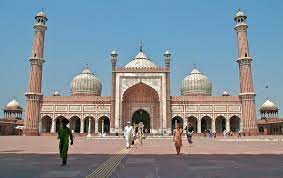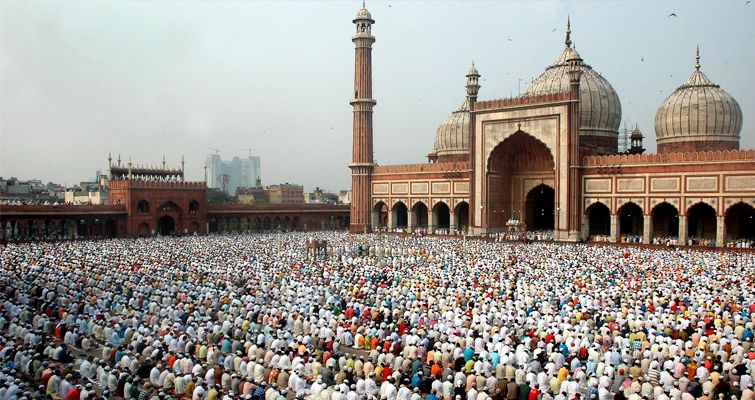

The mosque has two names. The older one, bestowed by Shah Jahan, is 'Masjid-i-Jeh?n-Num?', roughly translating to "mosque commanding the view of the world" in Persian and Urdu. The other more common one is 'Jama Masjid', which emerged among the common populace. Its literal translation in Arabic is "congregational mosque." It is used in the sense of 'Friday mosque' (Juma Masjid), since this is when the congregational prayer is held. The term 'Jama Masjid' is not unique to Delhi's mosque; since the 7th century, it has been used in the Islamic world to denote the community mosque, and hence many around the world bear this name and its variant Mughal Emperor Shah Jahan built the Jama Masjid between 1650 and 1656, at the highest point of Shahjahanabad. The mosque was designed by architect Ustad Khalil, and constructed by approximately 5000 workers. The workforce was diverse, consisting of Indians, Arabs, Persians, Turks, and Europeans. The construction was supervised primarily by Sadullah Khan, the wazir (or prime minister) during Shah Jahan's reign, and Fazil Khan, the comptroller of Shah Jahan's household. The cost of the construction at the time was ten lakh (one million) rupees. The mosque was inaugurated on 23 July 1656 by Syed Abdul Ghafoor Shah Bukhari from Bukhara, Uzbekistan. Shah Jahan invited him to be the Shahi Imam (Royal Imam) of the mosque. The mosque was one of the last monuments built under Shah Jahan. After its completion, it served as the royal mosque of the emperors until the end of the Mughal period. The khutba was recited by the Mughal emperor during the Friday noon prayer, legitimizing his rule. The mosque was hence a symbol of Mughal sovereignty in India, carrying political significance. It was also an important center of social life for the residents of Shahjahanabad, providing a space transcending the class divide for diverse people to interact. The British took over Shahjahanabad in 1803. The Mughal Emperor remained the ritual imperial head of the mosque, but Mughal power and patronage had significantly waned. The initial policy of the British in the city was favorable towards its residents; the British undertook repairs and even renovations of the Jama Masjid. The Masjid continued to serve as a site of social and political discourse, in keeping with other mosques of Delhi; for example, theological and philosophical debates were held between Muslims and Christians. The Revolt of 1857 was a significant turning point in this situation. This event resulted in the deaths of many British people in the city and weakened colonial authority, deeply affronting the British. It also ended the Mughal empire. The British perceived the revolt as instigated by Muslims, cultivated within Delhi's mosques. After the British reclaimed the city in the same year, they razed many mosques and banned the congregation of Muslims in any remaining mosques. The Jama Masjid fell into British confiscation during this time and was barred from any religious use. It was repeatedly considered for destruction, but the British eventually began using it as barracks for its Sikh and European soldiers. This was a desecration of the spaces to insult the sentiments of the city's Muslim inhabitants. The Masjid was eventually returned to the Muslim population in 1862 due to their increasing resentment of British actions. Multiple conditions were imposed, including the usage of Jama Masjid as strictly a religious site and mandatory policing by the British. The Jama Masjid Managing Committee (JMMC), consisting of respected Muslims of Delhi, was established as a formal body to represent the mosque and enforce these conditions. Upon its return, the Jama Masjid was reestablished as a mosque. Though the Mughal state had been dissolved, the mosque received patronage from various regional Islamic rulers and nobles. In 1886, the Nawab of Rampur donated a large sum of 1,55,000 rupees to facilitate repairs. In 1926, a donation from the Nizam of Hyderabad of 1,00,000 rupees was used for similar purposes. Growing unrest against British rule manifested in Delhi's mosques from 1911. The Jama Masjid was frequently used for non-religious, political purposes, against the rules instituted. While the British could police and clamp down on political activities in public spaces, the Jama Masjid was a sacred space and was hence protected from such action by both law (Religious Endowment Act, 1863) and the sentiments of Delhi. Hindus often gathered with Muslims in the mosque to express anti-colonial solidarity despite simmering tension between the communities in the colonial period. The Jama Masjid continued to be a political symbol after independence. The Partition of India was underway, causing massive population movements in Delhi. Indian independence activist Abul Kalam Azad delivered a speech from its pulpit during the Friday prayer of 23 October 1947. Azad implored the Muslims of Delhi to remain in India and attempted to reassure them that India was still their homeland. In 1948, the last Nizam of Hyderabad, Asaf Jah VII, was asked to donate 75,000 rupees to repair one-fourth of the mosque floor. The Nizam instead sanctioned 3,00,000 rupees, stating that the remaining three-fourths of the mosque should not look old. The mosque served as a site of significance with regards to the infamously communal Babri Masjid dispute. Abdullah Bukhari, the Shahi Imam of the Jama Masjid, made several speeches in 1986 regarding the issue from the Masjid, condemning the political support given to the Hindu cause and mobilizing Muslim sentiments. In 1987, Jama Masjid was the staging point for a major peaceful protest regarding the Babri Masjid dispute. On 28 May 1987, amidst rising communal tensions and riots all over India, the Jama Masjid was closed by the Imam and adorned in black cloth, symbolizing Muslim resentment of government actions at the time.